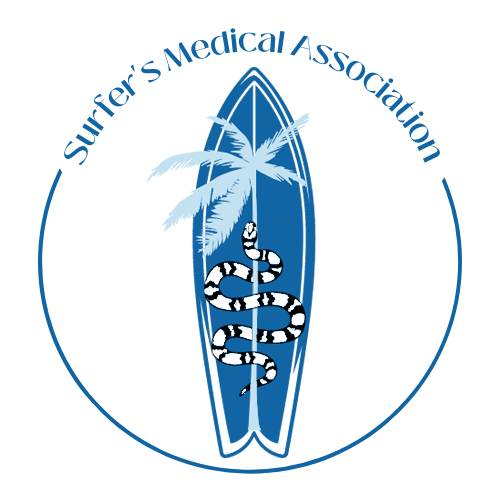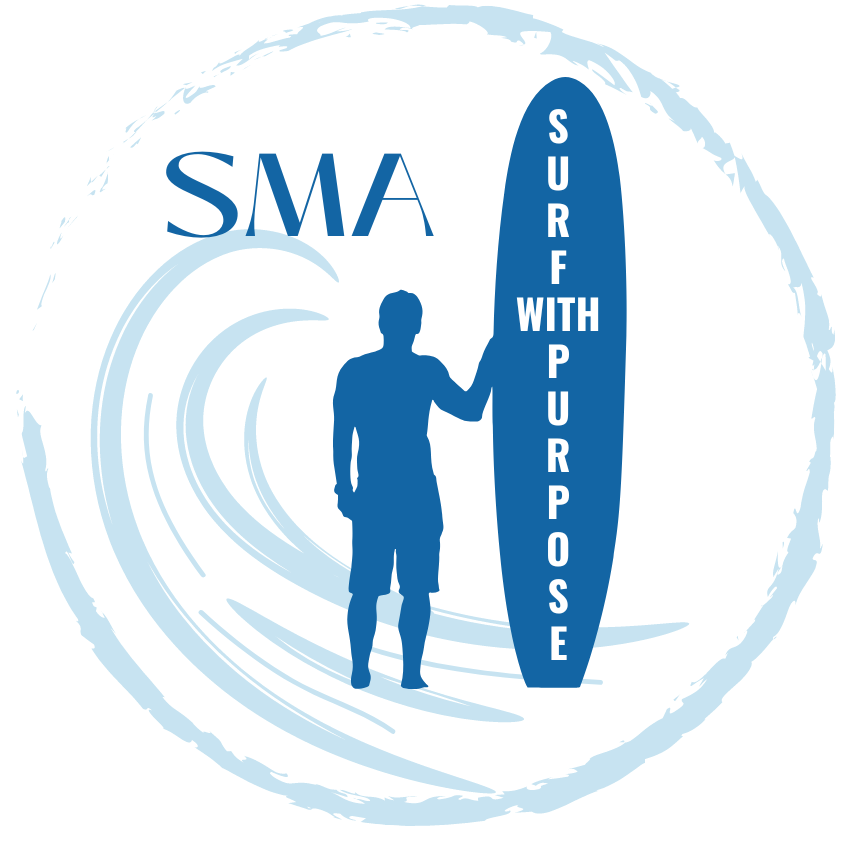A Surfing Life
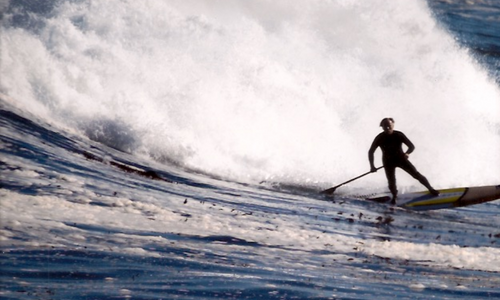
William “Bill” H. Jones, PhD. EMT
A seventy year old looks at 58 years of surfing and how surfing has changed for me, physically, medically and mentally.
My first stand up surfing wave was on a 9ft Surfari pop out board at Huntington Beach in summer 1960. Prior to that, I had body surfed, rubber mat surfed (a surfo) and surfed home made plywood paipo (belly) boards at Huntington. The wave was a chest high wave on the south side of the pier and I glided quite a ways I thought. I was hooked. I was 12 and had a world of surf ahead of me.
I was a pretty good surfer and competed in the old WSA and was a team rider for Aqua Jet Surfboards, the original hollow honeycombed board. They were great boards until they started to leak. I traveled around California, to Mexico on school breaks. My senior year of high school my parents moved to Connecticut and as a result, I surfed spots in Rhode Island, Long Island, New Jersey shore and some other spots south down to Florida. It was 1966, I long boarded and my station wagon had California plates. I was hot.
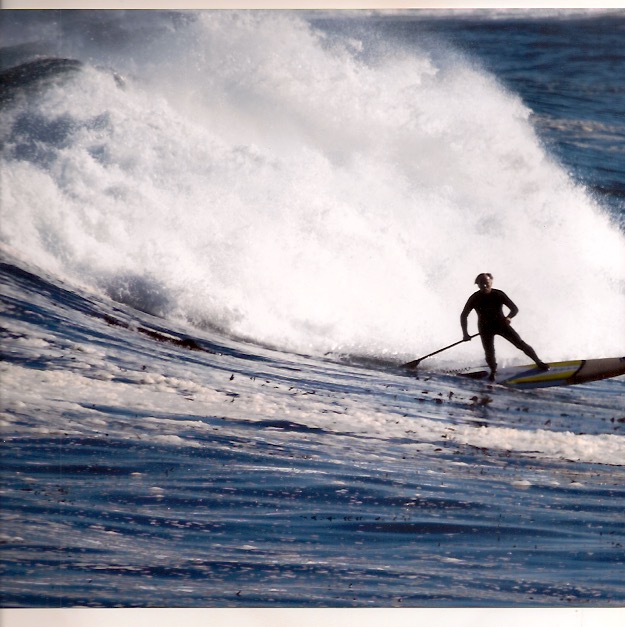 My best surf years, I believe were ages 40 to 48. I travelled to Hawaii several times, surfed Fiji, Mentawais, Mexico and Central America. I was healthy, in good shape, was a runner and marathoner and weighed 170 lbs. I could stay out in 50-55 degree water for hours at my home breaks in Monterey and Santa Cruz.
My best surf years, I believe were ages 40 to 48. I travelled to Hawaii several times, surfed Fiji, Mentawais, Mexico and Central America. I was healthy, in good shape, was a runner and marathoner and weighed 170 lbs. I could stay out in 50-55 degree water for hours at my home breaks in Monterey and Santa Cruz.
In late November, 1998, I was checking surf at Carmel Beach and my back really hurt in the shoulder area and seemed to be getting worse. Thus began my 20 year saga of medical events, trauma and aging related health issues. Six hours later was I was admitted to the local hospital, medicated with morphine and prepped for a fusion of cervical vertebrae 5/6 using my own hip bone. While in surgery, my 6/7 disk ruptured, I was coding, but then returned to normal. I left the hospital a week later with a neck brace and a new way to look at life.
During my 5 months out of the water, I did daily drive by’s at the beach and would stop and talk with surf buddies if they were there. At almost 5 months rehab and recovery, I was given the OK to return to the water. The first few go outs were miserable, just getting to a standing position and maintaining balance took several seconds where as before, it was a quick and spontaneous maneuver.
From 1999 until 2006, I had 4 ankle operations on my left ankle. I had a fracture of my talus bone, which I believe was a series of accidents. I had a late take off at Macaroni’s in the Mentawei Islands and got pitched over and hit the reef with my left heel as point of impact. This coupled with a declining running ability led to a unsuccessful allograph, debridement, plates, screws and finally an operation to get all the hardware out and a life of increased arthritis effects.
During these years, I surfed occasionally when I could, boogie boarded with one fin and tried to stay water and surf connected. I was also in a wheelchair and crutches for months at a time. A couple of things helped in keeping my surf stoke going, daily checks of my home breaks, checks of Surfline, which was just hitting its stride and surf magazines. Also I had some friends that kept telling that I was not missing much, but I did.
About this time, I started to kayak and that helped a bit with water contact, but it was not the same. As I neared the end of my ankle problems, I was hit with two other significant health issues. In 2004, I was diagnosed with “pre diabetic symptoms, but with diet, exercise and oral medications, I was doing ok and started to see an endocrinologist. Then my second medical condition arose. After surfing one day in 2005, I can home and was doing yard work, when I went into A-fib.
I am 55 years old and now a Diabetes 2 patient with A-fib. I was able to go on my trip with college buddies to Baja to surf and play to celebrate our “double nickels” milestone, but I was on guard and on watch for medical events and really watched what I ate and drank. Good-bye to cold beers, nachos and other stuff, as well as triggers for A-fib and high blood sugars.
From 2005 to 2010, I had 3 heart ablations as my A-fib continued, each procedure a bit more difficult. I was on blood thinners and as a result, my travel to exotic places with sharp coral reefs was significantly cut back. I was on meds for Diabetes 2, on meds for A-fib and just starting to get into SUP and paddling on a 12’1” Laird SUP, a behemoth that at least got me in and on the water.
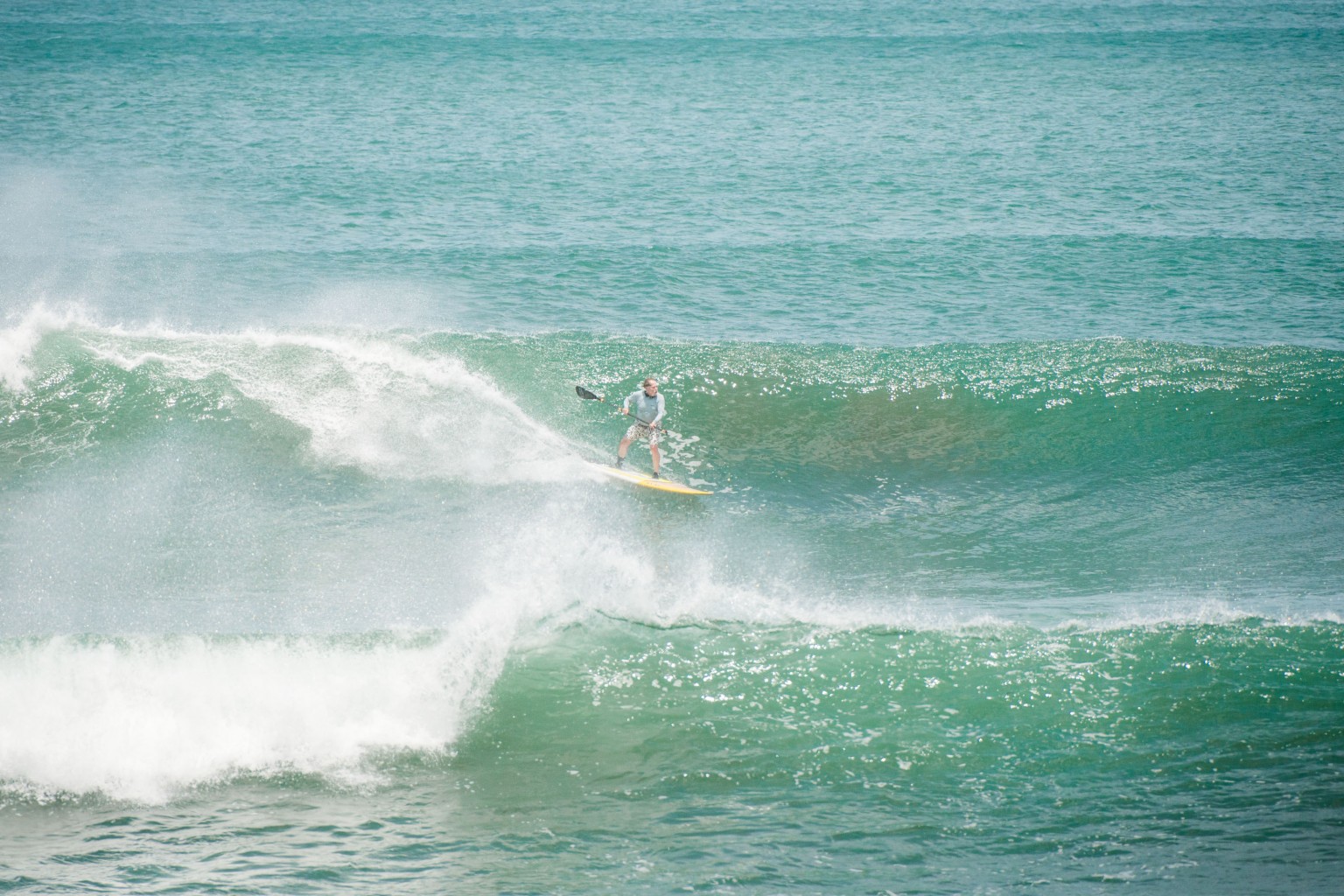 In 1998, my quiver of boards numbered 16 with a 6’4” to several old long boards. I started to favor longer and wider board as my medical conditions continued and my performance started to effect my time in the water and how much fun I was having. My board started to get longer and wider and in 2010, my boards were all in the 8’ to 9’ range with a 12’1” Laird board.
In 1998, my quiver of boards numbered 16 with a 6’4” to several old long boards. I started to favor longer and wider board as my medical conditions continued and my performance started to effect my time in the water and how much fun I was having. My board started to get longer and wider and in 2010, my boards were all in the 8’ to 9’ range with a 12’1” Laird board.
In my surfing, I had noticed that from 2008 to 2010, that my time in getting up from prone paddling to standing up on the wave was significantly decreased and my epiphany came at Cloudbreak surfing with Dr. Norm Vinn when we watched fellow SMA buddies scoring on double overhead waves. Norm looks at me and said, “We are not surfing anymore, we are just bobbing for waves.” Well that hit home big time for me. Out of 10 waves that day, I made 2 waves and had noticed that what had taken me a split second to get to my feet and be in the wave was now taking 2 seconds and placing me in the extreme critical part of the wave and I was getting pitched out, over the wave and getting my reef time.
The next day after Norm’s observation, was the day all surfing spots in Fiji became open to the public. Everybody was at Cloudbreak and it was a zoo. I used one of Tavarua’s SUP’s and along with another fellow we surfed Restaurant’s at a bit overhead and I had a blast. That was the day, I became a confirmed SUP grom.
Upon coming home, I bought another more surfing style SUP’s and was in the water most days either surfing or paddling. My attitude had completely changed. I was a grommet again. I was stoked, I was having fun and it was a blast.
I believe that my A-fib has been corrected and I am not on any medication other that a very low dose statin and aspirin once a day. As time went on I was having crazy blood glucose levels with extreme lows and highs. I was put on a variety of medications including Metformin, Actos, Glucophage, Novalog and Lantus to help with my high BG level and rising A1C.
In 2014, I started to lose weight and had intense pain in my lower left abdominal quadrant and was my only relief was using the hot tub and an occasional paddle to just get my mind off my pain. I had a total of 6 endoscopy and colonoscopies and biopsies and we came away with the results that I had “some sludge” in my pancreas. My surfing general practioner ordered an MRI and the results revealed, I had pancreatitis and a pseudocyst that pretty much covered my pancreas. Little did I know that the Actos, I had been taking was a prime suspect in pancreatitis.
I met with a surgeon with a great reputation and I was to have the pseudocyst and part of my pancreas removed. The operation would be done with minimal invasive arthroscopic procedure. In surgery, after about an hour, the surgeon muttered “oh shit”, I believe, and removed all of the arthroscopic devices and made an “L” shaped incision about10-12 inches in my abdominal area. My organs were “communicating” with each other and he had to use his hands to take care of the adhesion. My spleen, gall bladder and one half of my pancreas were removed along with a 10cm x 6cm psuedocyst. I was in the hospital for a week and started to use insulin with a pump as my main source to deal with the diabetic effect.
As soon as my stitches were out and I had the ok to go in the water, I was paddling in the Monterey Harbor., even though I was weak and had significant weight and muscle loss. I started out paddling about 15 minutes, then to 20 and so on until I could do an hour and a half. Three months after the operation, I hit my first surf at a local spot called Dunes and was able to get 3 waves that were head high, but I noticed that I needed to build up my strength and endurance.
In March 2016, I had another medical event and had my left thumb, rebuilt and configured, as it was bone on bone. I had 2 metal pins put in for 8 weeks to hold the thumb and immobilize it. At three months I was back in the water and paddling and surfed again at five months post surgery.
The depressing fact that I am aging and the fact that my skills are in decline is an ongoing battle. In June, 2017 I did a boat trip in the Maldives and noticed that my endurance is not like it use to be, even if the waves were really good. I could SUP for a little over an hour, with a morning and afternoon go out.
SUP’s are about as welcome in a competitive surf break, as a chronic STD in a bordello. Three Aussie fellows gave me the “stink eye” at one break in the Maldives, but I took the initiative with the following: “I know that you are not happy to see a SUP out her and I wish I could use a regular board, but I am 70 years old have had a multitude of health factors. I will surf for an hour or so get 4-8 waves and be out of here.” They smiled and we surfed in a congenial manner.
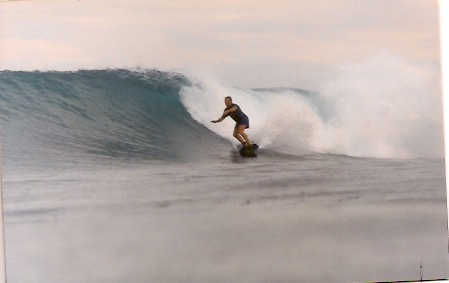
I continue to deal with health issues daily with Blood Glucose highs and lows. I wear a waterproof Omnipod insulin pump with fairly good results. I monitor with 8 to 10 a day and treat the BG lows and highs as they occur. I am looking at BG monitors, but there are none that are waterproof and I have to look at how they would impact my lifestyle and activity level. This is my biggest stressor at this time.
Most of the medical events, procedures and operations, I went through have been a minor inconvenience. Mentally several things have kept me going.
- I have tried to stay in shape physically. I go to the gym 5 days a week and do 1.5 hours of cardio, stretching, swimming and drinking coffee and shooting the breeze with gym buddies.
- I do a surf check drive by every day at a couple of spots and go the beach to walk my dog.
- I have a close network of several other SUP buddies and we have breakfast once every two weeks and get together for coffee early in the morning. We also plan surf trips. Mexico, Maldives, Galapagos, etc…
- Focus on what you are able to do and look at new ways to figure out how to continue to do the things you love.
At the 2012 SMA Galapagos Conference we had a discussion and on how to “Keep the Stoke” of surfing and dealing with declining competence in the aging surfer.
This conversation was started several months ago after the Tubesteak Tracy article in The Surfing Medicine Journal #25 was published. Following are some suggestions to enhance the surfing experience for maturing SMA members.
1. Focus on more quality wave experience rather than the quantity.
2. Look at alternative sports and activities that are water oriented. Kayaking, SUP paddling, surf photography and other water based activities can help in staying contacted to the ocean.
3. Focus more on surfing friendships and interaction rather than agro-aggression and quantity of waves. Focus on the “Art of Surfing” not on the destroying a wave and being a surfer who wants to impress others.
4. Acknowledge your surf buddies injuries and limitations and help them remember what they use to do. Keep the memories alive.
5. Keep your surfing morale high and work on keeping the stoke. Help others in the surfing world, by coaching, volunteer judging a contest, working with veterans or those with disabilities to understand the thrill of surfing.
6. Connect with the waves daily, by going to the beach, walking your dogs there, watching the ocean with friends and even checking Surfline.
7. Challenge yourself to learn a new aspect of the surfing culture. Try a SUP, ride a boogie, body surf or just swim. Get into or stay in good physical shape.
8. Ride a bigger board.
Tubesteak Tracy closes with several quick tips that keep this message very simple:
“You may not be as bad as you feel.”
“The only person who can take away your surf stoke is you.”
“You go till you no mo can go.” Saburo, Hawaiian mentor
As an aging surfer myself, I am almost 100% doing SUP surfing now. Aging pro surfers and former pros and surf icons, now embrace SUP. I paddled next to Mickey Munoz at the “Battle of the Paddle” at Doheny in September 2011 and it was great to see an almost 80-year-old surfer still stoked.
Elizabeth Kubler-Ross in her articles and books on death and dying details the stages one goes through in dealing with death. In losing the ability to perform and function as you once did in a sport or physical activity we love, we as surfers go through the same stages of anger, denial, bargaining and finally accepting where we are. Many of us have had former surfing buddies who just quit and go cold turkey.
Surfing is hard to give up, but if one starts to think about ways to change your approach to a passion or hobby, when it becomes difficult, that is the beginning to the adjustment to aging. I hate to say this, but I would have given up surfing several years ago (I can hear and see local surfers applauding), because it was no fun anymore. SUP is a gift, because it maintains the thrill of surfing in a new way and keeps you in the water.


